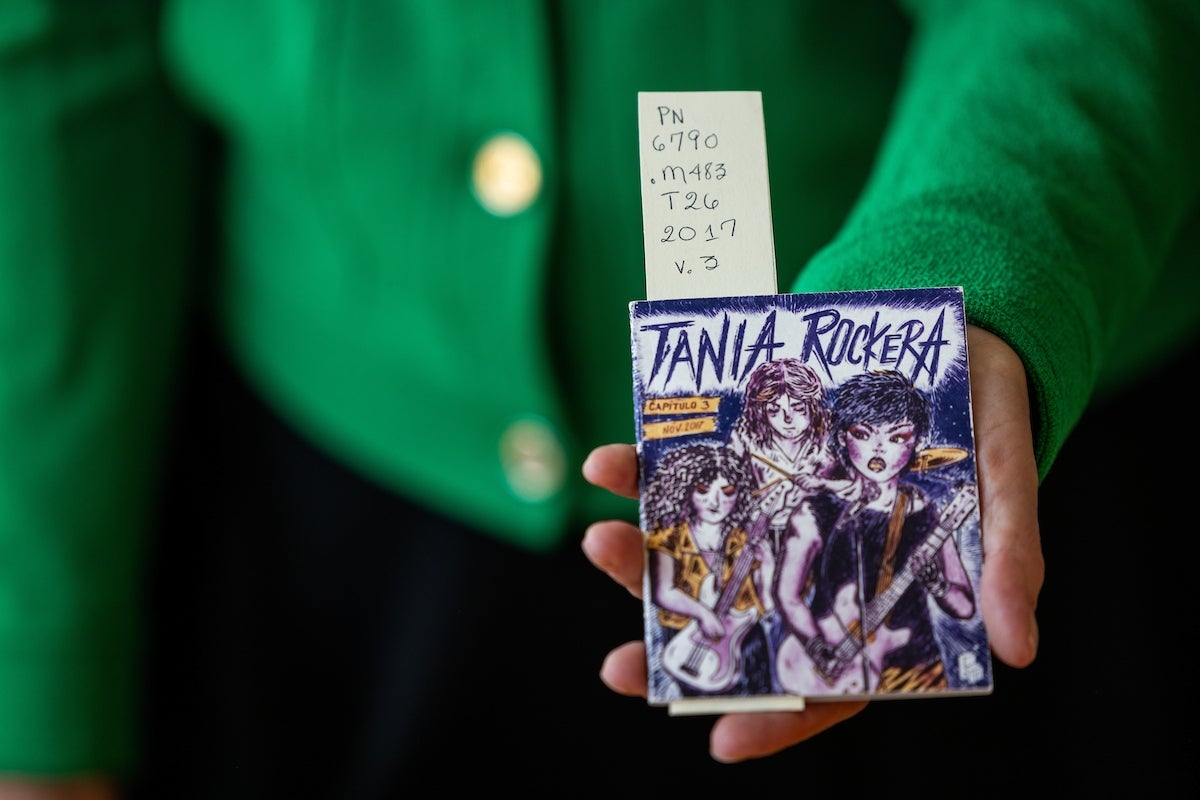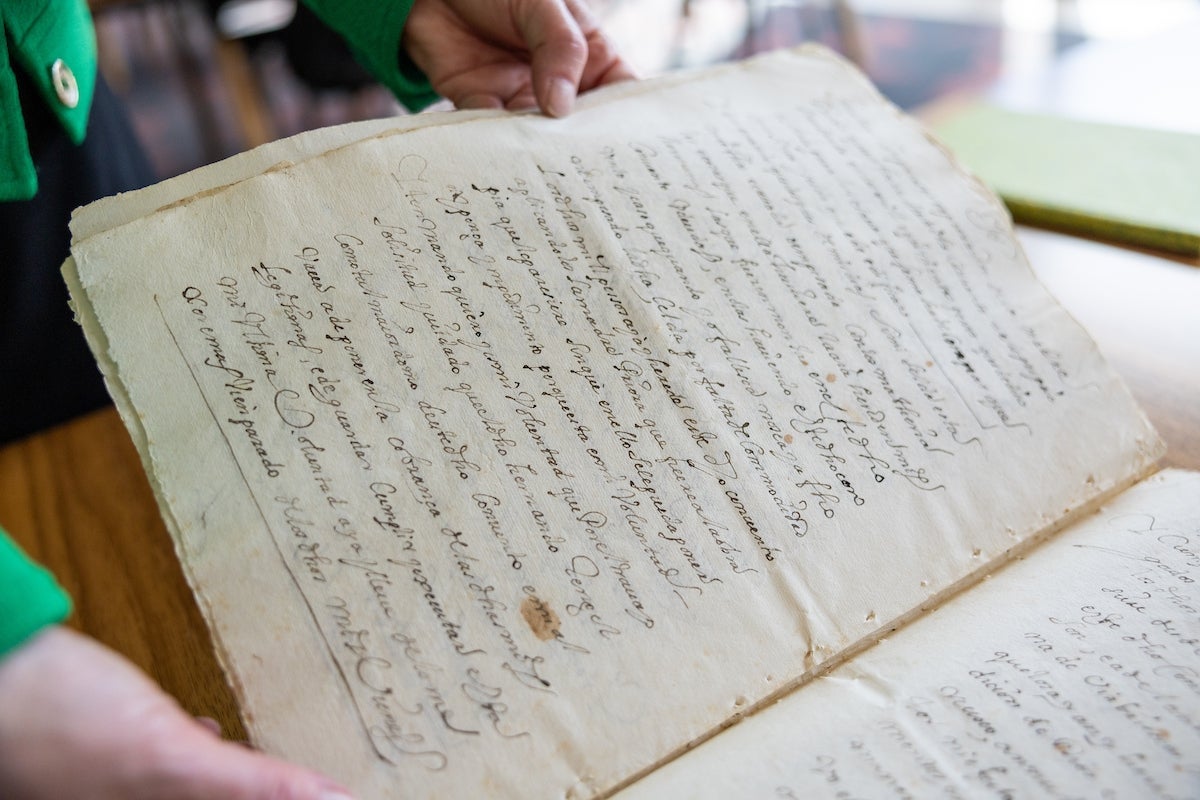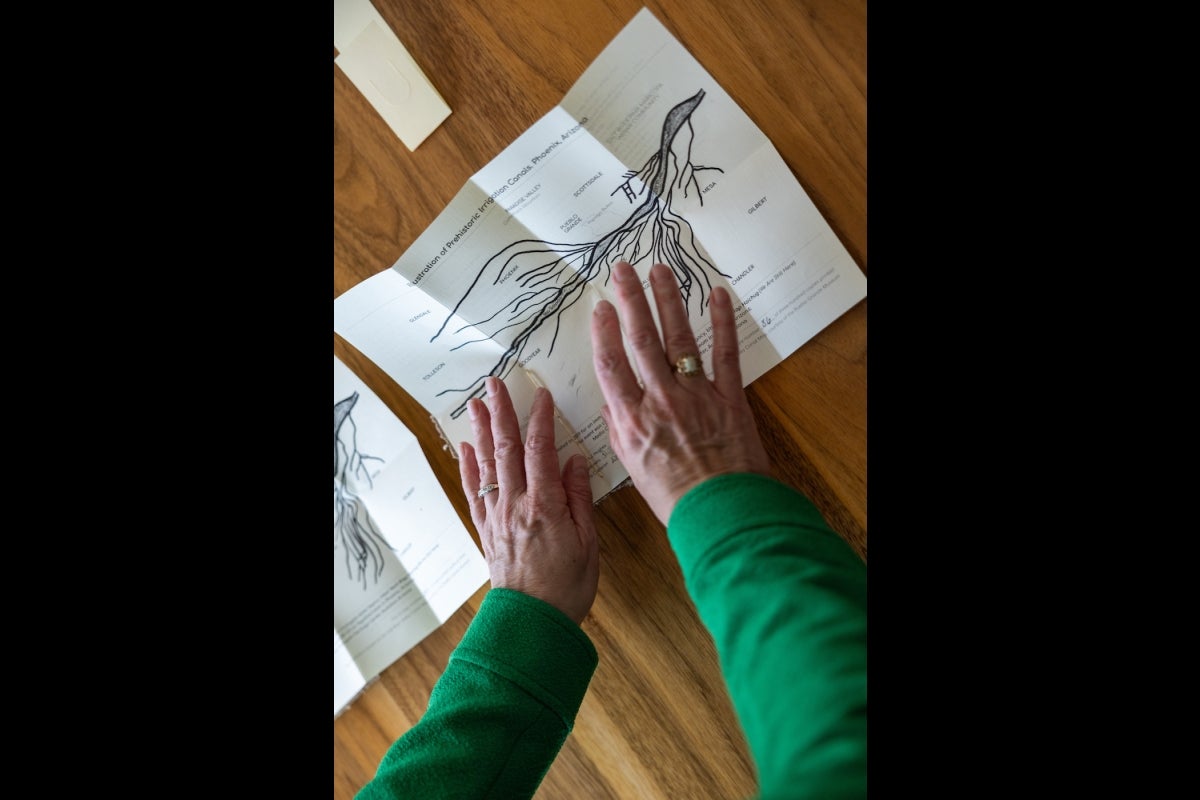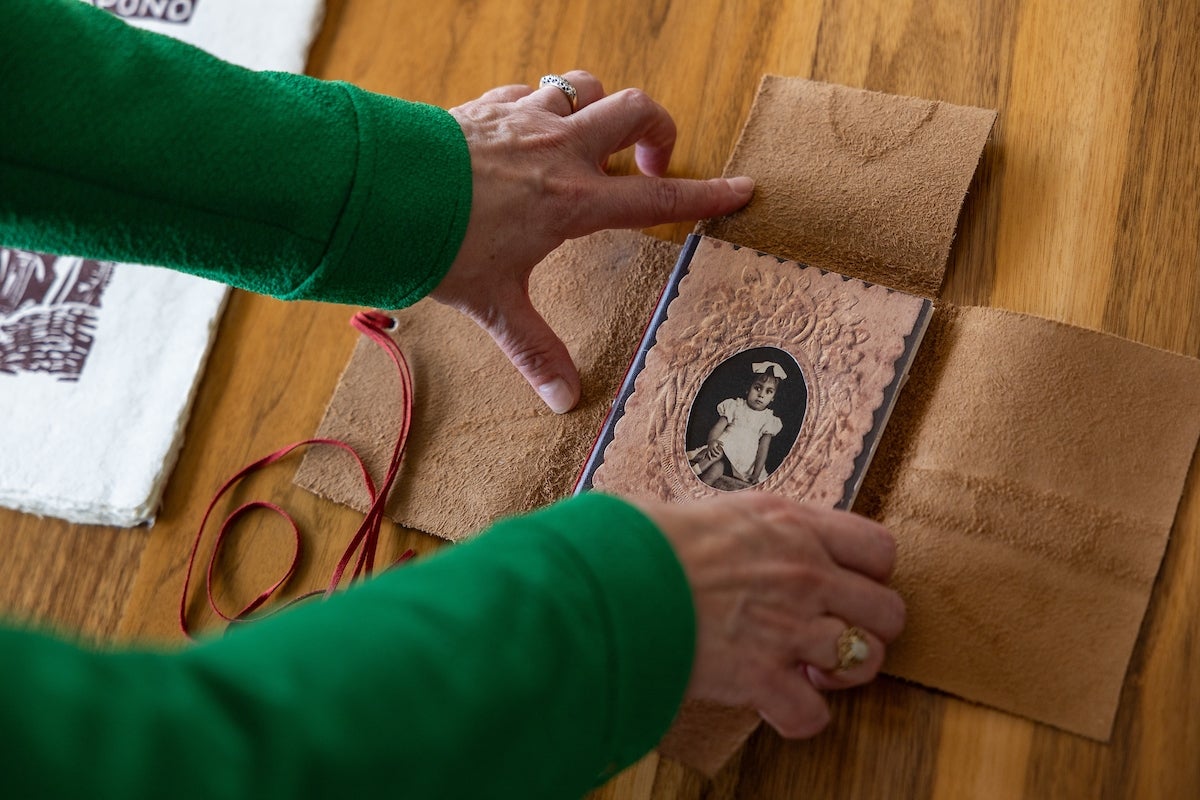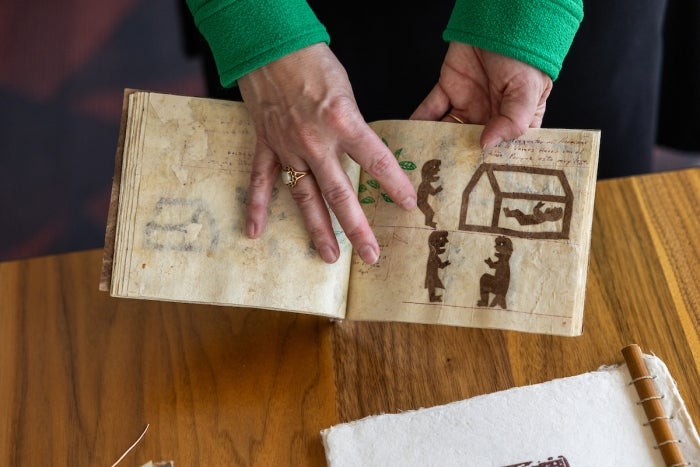Voices from Latin America can be found in dynamic ASU research collection

Seonaid Valiant, associate curator for Latin American studies and interim curator for Rare Books and Manuscripts at the ASU Library, has been working with faculty and students to build a unique research collection since her arrival in 2017. Photo by Deanna Dent/Arizona State University
Editor’s note: This is part of a monthly series spotlighting special collections from ASU Library’s archives throughout 2024.
Rebellious nuns. Punk artists. Ecofeminist criticism through the lens of Indigenous and Afro-Brazilian peoples.
These are all voices of a rich, cultural mosaic. And they’re all in one archive at the Arizona State University Library.
See the collection
To make an appointment to visit ASU’s Latin Americana Collection, visit ASU's Ask an Archivist page.
The Latin Americana Collection is expansive, eclectic and transdisciplinary. It covers literature, history, culture and art, social sciences, magic and medicine, and speaks to themes of overcoming resistance.
In celebration of Women’s History Month, this particular collection offers a rich variety of materials that showcase the contributions of women in Latin America.
“The Latin Americana Collection is the largest collection in the Southwest that focuses on issues of culture, gender, religion, magic and politics,” said Seonaid Valiant, associate curator for Latin American studies and interim curator for Rare Books and Manuscripts at the ASU Library.
“It has been curated specifically to contain handmade objects and research material that express points of views of individual artists as well as communities, and that helps researchers get deeper into topics," Valiant said. "More importantly, what we have here are voices from Latin America, not just voices about Latin America.”
Dating back to the 1500s, the collection contains a mixed media of diaries, notebooks, woodcuts, correspondence, manuscripts, artists’ books, small press books and zines.
It was started in the 1960s but took on a new life when Valiant was hired in 2017.
“ASU has always had someone dedicated to cataloguing and overseeing the Latin Americana Collection but when I joined the ASU Library, they made a conscious decision to have a curator,” said Valiant, a specialist on the history of manuscripts and antiquities, and an author who holds a PhD in history from the University of Chicago. “That meant that I could work with donors, and I could oversee a budget for purchasing items, in order to make this a destination collection for people to come and research.”
One of the earliest acquisitions Valiant oversaw was “Neptune’s Allegory,” a rare, first-edition copy of a 17th century literary work of Sor Juana Inés de la Cruz. A premiere poet of the Americas and an early feminist, Sor Juana joined a convent, in part, to devote her life to the study of science, philosophy, writing and art. The booklet is one of two known copies that exist.
“Since the pandemic, we have seen a renewed interest in work that celebrates the joy of being together. The essay was written for a particular ceremony and gives us deep insight into the elaborate arrangements for that day,” Valiant said. “In this writing, Sor Juana reveals her deep knowledge of classical iconography and demonstrates that women can be the mediators of the connections between Europe and Mexico.”
The booklet is also part of a loose assembly of material Valiant unofficially refers to as “The Convent Collection,” which includes hand-written poems and manuscripts by nuns describing their daily lives.
“Nuns were some of the first women to talk about women’s issues, specifically Mexican nuns of the 17th and 18th centuries. They’re some of the first people in the Americas to start using the phrase, ‘I have these needs,’” Valiant said. “They expressed the need to worship, the need to write poetry, the need to not marry and be childless. They were some of the most verbal people in the Americas and they are models for how women can develop their intellect, how to be independent, but also, how they fit within a community.”
Academics like Fernanda Oliveira, a professor at Federal University of Rio Grande do Sul in Brazil, visited the collection while on campus to see what primary sources she and her students could find. She wanted to identify Black authors who work with Black history in Latin America for a research project. She said she’ll use the research in a variety of ways.
“One of them will be for disseminating knowledge about Black populations in Latin America. For example, Ricardo Rodrigues’ material is very interesting for public dissemination,” Oliveira said. “On the other hand, the collection is very important for increasing knowledge about Black thought and will help me understand a complex story about freedom, power, existence and other elements that go far beyond the history of slavery.”
Valiant said even though the collection is emerging, it has a lot of things going for it. She pointed to the Ruben Dario Papers 1882 to 1945, which contains approximately 900 handwritten pages of poetry, essays, short stories, diplomatic memos and personal letters. The Nicaraguan poet, journalist and diplomat is widely considered the founder of Spanish American modernism, a 20th-century Latin American literary movement.
“His papers are heavily used by graduate students because of his poetry and because he was a prominent Latin American person who may have been bisexual,” Valiant said. "This idea makes the collection of interest to a new set of researchers."
Undergraduate students have also become familiar with the collection thanks to class visits with Cynthia Tompkins.
“Students seem to learn better when they can see items and hold it in their hands,” said Tompkins, a Spanish professor in the School of International Letters and Cultures. “They can look at illuminated and handwritten manuscripts, read a poem by Alberto Ríos, or see how books are folded like an accordion.
“As a postmodernist, there’s a time difference between what you touch and what you think. And whatever you can touch is still permeated through language. It’s important for the students to experience the material phenomenologically.”
Beyond the famous names and the rarity of the items in the collection, the style and variety of books and zines, how they’re made is also a lure to scholars and students.
Cordels are zine-like books from Brazil that tell contemporary stories using poetry, prose and illustrations. The first ones emerged from Indigenous and Afro-Brazilian poets in northeastern Brazil after an introduction by the Portuguese in the 16th century.
Cordel is a Portuguese word for rope and refers to how they were traditionally sold: hanging or clipped to a piece of string in a marketplace. The collection features approximately 100 of these small zines.
“A cordel started as a small book of poetry with a wood block print cover,” Valiant said. “It’s usually political, very anti-government, and women often use it as an opportunity to talk about the challenges that they face, including their own physicality.”
While the collection offers many themes, sustainability emerges as one of its threads.
Cartoneras are short books of prose or poetry where Argentine writers and artists have used recycled materials collected off the streets by “cartoneros,” or garbage pickers, who sell the cardboard to publishers at a discounted price. Book covers are usually hand-painted and the inside text is photocopied.
Cartoneras are often sold in amounts of 100 or fewer and are highly collectible.
“These books started becoming popular around the millennium to show that we need to stop producing so much garbage,” Valiant said. “Several publishers have emerged out of this genre.”
The collection of facsimiles of Mexican codices is comprised of pictorial and textual manuscripts that chronicle Mexican Indigenous heritage before contact with the Spanish. It is rare to have such a large collection of them, and ASU has over 50.
“The collection is important because it is not possible for libraries to acquire original documents like these,” Valiant said. “Working with these near exact replicas, in person, is the second-best way to study these manuscripts, which reveal so much about the early modern lives of Indigenous people in Mexico. We get a lot of students coming in for these.”
One of the more recent student visitors was Ramon Folch, a graduate student in Mexican archeology and a participant in ASU Library events celebrating the collection. He said the Latin Americana Collection has some of the most comprehensive books on Mexican archeology and history.
“I am particularly fond of the rare, edited volumes from the Mexican Congress in the mid-20th century, which are packed with rare articles and chapters,” said Fulch, who is enrolled in ASU’s School of Human Evolution and Social Change. “I have found dozens of unexpected sources by browsing around.”
Wood block prints are also a vital part of the collection, which also played an important role in Latin American storytelling. In a series of prints, known as “Via Sacra de Antonio Concelheiro,” printed in black ink on white paper, printmaker Joel Borges illustrates the Canudos War in Brazil from 1896 to 1897. Approximately 30,000 men and women were killed during uprisings between Bahia citizens and the Republican government.
The prints were donated to the ASU Library by Mary Karasch, a professor emerita from Oakland University in Rochester, Michigan, who now lives in Tempe, Arizona.
“Given the size of Phoenix, we need a center for research for Latin America, not just the borderlands,” said Karash, who started collecting wood block prints and handmade books in 1969 when she was a graduate student. “My objective in giving these items was to build up the collection. I specifically wanted to donate them to an academic library because they’re invaluable to scholars and students.”
Karash said viewing digital items has its place, but seeing, touching and feeling primary sources is where real learning occurs.
“When I was an undergraduate, I used to get very frustrated because our professors would have us reading secondary sources only,” said Karash, who has collected Brazilian art and books for more than half a century. “We never got to see original letters or documents until grad school, but this has now changed and evolved.”
That evolution will continue as the collection expands in scope and depth, Valiant said.
“Our collection in terms of Latin American collections is small, but it’s big for Arizona and becoming significant,” said Valiant, who noted that ASU has approximately 400 faculty members affiliated with Latin American study. “It takes time to cultivate and build a collection, but in a just a short time, this one has become important enough to be a destination for scholars.”
Valiant said that as ASU's relationships with Latin American partners expand, she will continue to work with faculty and students to meet their research needs to help them achieve their academic goals.
"I do this remembering that this collection is not just for us, at this moment," she said, "but is also entrusted to us on behalf of the future students of ASU and the people of Arizona."
Monthly series spotlighting ASU Library’s special collections
- January: Expanded Theatre for Youth and Community Collection remains a repository for emerging artists and educators
- February: Black Collections aims to document the lives of an underrepresented Arizona community
- March: Voices from Latin America can be found in dynamic research collection
- April: Thunderbird archives: These walls do talk
- May: Collection preserves legacy of modern architects, buildings in the Southwest
- June: LGBTQ+ Studies Collection a repository rich in legacy
- July: Pop-up book collection is deceptively simple fun
- August: A (re)source of Sun Devil pride
- September: Chicano/a Research Collection filled with action, education and activism
- October: ASU collections offer Indigenous perspective through traditional storytelling, innovative methodology
More Arts, humanities and education

ASU alumna makes her way back to the ASU Gammage stage for '¡azúcar!'
As the Los Angeles-based CONTRA-TIEMPO dance group prepares for its upcoming production “¡azúcar!” at ASU Gammage, for one member of the dance group it is also a nostalgic return to her home.Born in…

ASU FIDM professor wins international award for fantastical, sustainable creation
The horror of an ailing Earth inspired an Arizona State University fashion professor to create a fantastical garment out of sustainable, re-used and found materials that won a prestigious…

ASU workshop trains educators, professionals from marginalized communities in disaster science
As devastating as hurricanes can be to anyone caught in their paths, they strike marginalized communities even harder.To address this issue, a fund named for a former Arizona State University…

